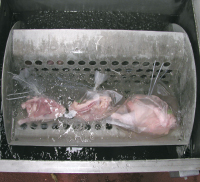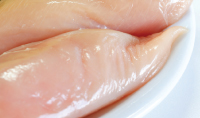
Chillin’ Chicken: Scientists study which method of chilling chicken works best
By By Sharon Durham Agricultural Research Service Information Staff USDA
Features Business & Policy Farm BusinessScientists study which method works best
Chicken processing is big business with almost 9 billion broiler
chickens being produced in the United States last year. Processing
birds efficiently and economically is the name of the game. And
researching ways to convert poultry into food that is safe for human
consumption is what Agricultural Research Service food scientists
strive to achieve.
 |
| CHILL COMPARISON Simulated immersion chilling using a technique of individually bagging broiler carcasses. The bagging prevents bacterial cross-contamination from one carcass to another. |
 |
Chicken processing is big business with almost 9 billion broiler chickens being produced in the United States last year. Processing birds efficiently and economically is the name of the game. And researching ways to convert poultry into food that is safe for human consumption is what Agricultural Research Service food scientists strive to achieve.
Quality and safety of poultry products for the U.S. consumer must be ensured. At ARS’s Richard B. Russell Research Center, in Athens, Ga., two ARS food technologists have examined the chilling stage of poultry processing to determine the best method for meat quality, food safety, and water management. Julie Northcutt is in the Poultry Processing and Swine Physiology Research Unit, and Doug Smith is in the Quality and Safety Assessment Research Unit.
CHILL OUT
“While immersion chilling is still the predominant method used in the United States, seven poultry-processing plants have recently switched to air chilling, and several others have made arrangements to install air-chilling equipment in the near future,” says Northcutt. This method may make significant inroads in processing in the United States and open new product markets, particularly in Europe.
It’s important that carcass temperatures are quickly lowered after slaughter to prevent bacterial growth. The industry standard is to bring carcasses to 40 F or less within four to eight hours (depending on carcass weight) after slaughter to inhibit growth of pathogens and spoilage micro-organisms. Pathogens are those bacteria that cause foodborne illness when consumed.
“Cooling of poultry is typically accomplished by one of three methods – immersion chilling, dry-air chilling, or evaporative air chilling,” says Northcutt. “In immersion chilling, carcasses are submerged in tanks of cold water or an ice and water mix. Dry-air chilling is achieved by blasting carcasses with cold air. Evaporative air chilling cools poultry down by a combination of cold-air blasts and water misting.”
Since, air- and immersion-chilling systems are now being used commercially, Northcutt and Smith worked with University of Georgia graduate student Roger Huezo to compare the effects of air chilling and immersion chilling on the microbiological profiles of broiler carcasses and meat quality.
Northcutt, Smith, and Huezo found no significant difference in bacterial pathogen levels between the two chilling methods. “Each of the chilling methods reduced bacteria populations to similar levels,” says Northcutt, “so once we discovered the similarities in carcass microbiology, we focused on water management and meat quality.”
CHEWY OR TENDER?
During commercial processing, whole carcasses are aged under refrigerated conditions to allow the muscle fibres to relax and become tender. After aging for a few hours, the carcasses may be cut into parts or deboned.
Northcutt and colleagues tested the most popular part of the chicken: breast fillets. They compared tenderness of fillets removed from carcasses immediately after chilling (0 hours aging) to fillets aged on carcasses for 150 minutes or 24 hours after chilling. For air- and immersion-chilling methods, all breast fillets were considered tender or very tender after 24 hours of aging, but shorter aging times caused variations in tenderness.
According to Smith, shorter aging times are of interest to the industry because plants have limited space to store carcasses after chilling, and the additional holding time is costly.
In the tests, immersion-chilled and air-chilled fillets were deboned immediately after chilling or after 150 minutes. The researchers found that 70 per cent of the immersion-chilled fillets were slightly tough to tough, and 30 per cent were tender to very tender. Of the air-chilled fillets, 44 per cent were slightly tough to tough, and 56 per cent were tender to very tender.
“In addition to improving meat quality, air chilling provided higher cooked-meat yields than immersion chilling. Colour and texture of skinless breast fillets were similar for both chilling methods,” says Northcutt. The team believes that the lower cooked yield of the immersion-chilled fillets was the result of high moisture absorption during chilling, which was later cooked out of the product.
The issue of aging only relates to poultry that is further processed. “Processors selling whole carcasses may not have a reason to make a switch to air chilling based on meat quality,” says Northcutt. “Air chilling may, however, be a suitable alternative for deboning and other processing operations.”
WATER, WATER EVERYWHERE – NOT!
The two principal poultry-chilling methods vary markedly in their water use. According to recent surveys, it takes an average of seven gallons of water to process each bird. Immersion chilling requires almost 3/4 of a gallon of water per bird to fill the chill tank at each shift startup and another half gallon of overflow — about 60,000 gallons depending on the length of the chiller.
The southeastern part of the United States is struggling to meet the water needs of its residents, and water costs are at a premium. “In 2005, some poultry processing plants in the South had to cut back on the number of birds they processed because water was not available. The drought has encouraged the privatization of water, with new companies being developed just to sell one of our most precious natural resources,” says Northcutt.
William Merka, former University of Georgia professor and poultry extension scientist, says water savings may be advantageous to processors. “Processors pay at least $4 for every 1,000 gallons for water and sewer cost,” he says. “If they can save even half a cent per bird with water conservation, that would save about $1,250 per day or $325,000 annually. But cutting back on water use is about more than just economics for the poultry industry; it’s also about the environment and water availability for future generations.”
Moving from immersion to air chilling would also involve a change for the processing plant and a learning curve for its employees. “One of the biggest concerns for the poultry industry is cleaning and sanitizing the areas associated with air chilling. It is much easier to clean and sanitize an immersion-chilling system,” says Northcutt.
Still, according to Northcutt, air chilling would save a minimum of one-half gallon of water for each bird processed. “Since 9 billion chickens were processed last year, that would equate to a savings of 4.5 billion gallons of water if all nine billion birds were air chilled,” she says. “But here’s the catch: air chilling takes longer – 90 to 150 minutes – than immersion chilling, which typically takes 50 minutes. If you consider time, energy cost, and yield, the two processes are economically equivalent.”
REGULATIONS TIP THE BALANCE
Water is at a premium in the Southeast, where residential and commercial users must compete for supplies. Stricter water regulations may help push conversion from immersion to air chilling. The rest of the Southeast is watching water restrictions in Georgia because it is the top broiler-producing state, at 1.3 billion chickens each year. Northcutt says that changes in Georgia typically affect the rest of the poultry industry.
“Currently there are seven plants in the United States that commercially air chill poultry and charge a premium price for the product. When air-chilled poultry products become commonplace, the price will drop, and there will no longer be an economic advantage to producing air-chilled poultry,” says Northcutt.
This research is part of Food Safety (Animal and Plant Products), an ARS national program (#108) described on the World Wide Web at www.nps.ars.usda.gov .
Julie Northcutt and Doug Smith are with the Richard B. Russell Research Center, 950 College Station Rd., Athens, Ga. 30604; phone 706-546-3592 [Northcutt], 706-546-3132 [Smith], or fax 706-546-3633.
Print this page